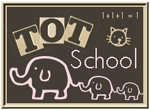1. Association 關聯
看到物品、聽到聲音,把二者產生關聯
1. 把兩樣(或三樣)物品從左至右擺在桌上。
2. 指著左邊的物品說:「這是A(例如正方形)。」指著右邊的物品說:「這是B(例如圓形)。」再唸一次,並鼓勵孩子也唸出聲來。
3. 把物品換位置,重複說:「這是B。」「這是A。」
2. Recognition 認知
聽到聲音、能夠辨認正確的物品
1. 把物品從左至右排列在桌上,重複命名說:「這是A。」「這是B。」然後問孩子:「B是哪一個?」「A是哪一個?」記得先問最後一個提到名字的,再問其他的。
2. 把物品打散,指著其中一個問:「這是A,還是B?」
或是藏起其中一個物品,問孩子:「A不見了,還是B不見了?」
3. 經常提供物品的發音,讓孩子去尋找正確的物品。
3. Recall 記憶
看到物品沒有任何幫助,可以發出正確的聲音
1. 把物品排列在桌上,在預測孩子可能會答對的情況下,問孩子:「這是什麼?」
2. 如果我們預估錯誤,孩子尚未能記住物品名稱時,要優雅的回到第二階段,多次練習,下次有機會再進入第三階段。
蒙特梭利特別強調第二個階段的重要性,因為大部分的家長,才教過孩子這是什麼之後,馬上就要考孩子,問他:「這是什麼?」完全忽略了第二個階段,沒有讓孩子聽聲音來分辨物品。孩子的大腦需要時間來消化、學習,因此第二階段的認知時期是非常重要的,千萬不可以跳過去,也不可以躁進的到第三階段。
Reference: http://carollwang-montessoriblog.blogspot.tw/2008/11/blog-post_2910.html
Montessori 3-Period-Lesson
Period 1: Naming
In this step, the desired vocabulary word is isolated (e.g., “cube”, “North America”, “seven”). In this case, say “This is a leaf” and repeat the word several times while pointing to the appropriate item or card.
Period 2: Association/Recognition
In this step, the child is called upon to show you the appropriate item or card. You should not indicate which answer is correct. Simply say, “Show me the leaf” and name the vocabulary word.
Additionally, you should begin with the last object or card that you ended with in Period 1. If the material is sandpaper numbers/letters, in this step the child may trace and say the number/letter after identifying it correctly. If the child is unable to identify the correct item or card, go back to Period 1, pointing to the correct item and saying the word.
Period 3: Recall
Now, you will point to an object or card and ask, “What is this?” The child will need to recall the name. If the child cannot recall the name, you may give them a hint by saying the beginning sound of the item. If necessary, return to Period 2.
These three steps may not happen all at one time. A child may proceed through Periods 1 and 2 and then not be able to complete Period 3. The next time you work with the material, they may be able to start right with Period 2 and move to Period 3. It’s different for each child. Some will need to repeat the steps more than others. The need for repetition is important for mastery, and should not be seen as something negative on the part of the child.
Reference: Montessori Basics 1 – The Three-Period-Lesson











































